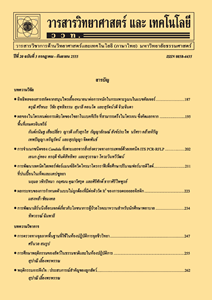Monitoring of Air Quality in Some Classrooms of Faculty of Science and Technology, Chiang Mai Rajabhat University
Main Article Content
Abstract
Indoor air quality directly affects the health of the occupants of the building. Since many people spend an average of 90 % of their days in buildings, it is important to monitor indoor air quality. This research aimed to monitor the indoor air quality of some classrooms of the Department of Environmental Science, Faculty of Science and Technology, Chiang Mai Rajabhat University. Physical factors (temperature, relative humidity, illuminance, and room-users), chemical factor (carbon dioxide concentration), and biological factors (bacteria and fungi concentration values) were recorded. Microorganisms were sampled using an air sampler MAS100 NT® (MERCK). Indoor air quality was monitored between October and November. Samples were collected in the morning and afternoon twice a week on Monday and Wednesday. The factors affecting indoor air quality were analyzed. The results revealed that the air quality in the classrooms often exceeded safe standards in terms of temperature, relative humidity, carbon dioxide gas and the number of bacteria. However, the degree of illuminance in both classrooms was found to be within the standard. There was a positive correlation between the number of bacteria, carbon dioxide concentration and the number of people in the room. Therefore, improvement in air quality should be initiated by the installation of exhaust fans and the regular cleaning air conditioner units. In addition, indoor air quality of intensively used areas should be frequently monitored.
Article Details
References
World Health Organization, 2006, WHO Air Quality Guidelines for Particulate Matter, Ozone, Nitrogen Dioxide and Sulfur Dioxide, WHO Press, Geneva, 20 p.
Ajavakom, N., Indoor Air Quality, Available Source: https://www.slideshare.net/ThitipornKlainil/1-7499580, July 23, 2019. (in Thai)
Katsakorn, A. and Phangchandha, R., 2015, Evaluation of indoor air quality conditions in classrooms, JPE 1: 238-247. (in Thai)
Supansomboon, S., 2017, The Study of Indoor Environmental Quality in Class rooms in Faculty of Architecture, Khon Kaen University Using Occupants’ Opinion, pp. 337-339, BTAC 2017, Khon Kaen University, Khon Kaen. (in Thai)
Lee, M.C., Mui, K.W., Wong, L.T., Chan, W.Y., Lee, E.W.M. and Cheung, C.T., 2012, Student learning performance and indoor environmental quality (IEQ) in air-conditioned university teaching rooms, Build. Environ. 49: 238-244.
Twardella, D., Matzen, W., Lahrz, T., Burghardt, R., Spegel, H., Hendrowarsito, L., Frenzel, A. and Fromme, H., 2012, Effect of classroom air quality on students’ concentration: results of a cluster–randomized cross–over experi mental study, Indoor Air 22: 378-387.
Feller, W., 1950, An Introduction to the Probability Theory and Its Application, John Wiley and sons, Inc., New York, 175 p.
Meier, R. and Zingre, H., 2000, Qualifica tion of air sampler systems: The MAS-100, Swiss Pharm. 22: 15-21.
Bureau of Environmental Health, 2016, Operating Manual for Indoor Air Quality Assessment for Staff, Department of Health, Ministry of Public Health, Nonthaburi, 95 p. (in Thai)
Jantarakot, S. and Chaiyakul, Y.,2017, Lighting for Classroom at Khon Kaen University, pp. 227-236, BTAC 2017, Khon Kaen University, Khon Kaen. (in Thai)
Oksanen, J., Blanchet, F.G., Friendly, M., Kindt, R., Legendre, P., McGlin, D., Minchin, P.R., O’hara, R.B., Simpson, G.L., Solymos, P. and Wagner, H., 2017, Vegan: Community Ecology Package, R Package Version 2.4-3, Available Source: https://cran.r-project. org/web/packages/vegan, July 23, 2019.
January, W., 2017, pca3d: Three Dimensional PCA Plots, R Package Version 0.10, Available Source: http://cran.nexr.com/web/packages/pca3d, July 23, 2019.
Johnson, D.L., Lynch, R.A., Floyd, E.L., Wang, J. and Bartels, J.N., 2018, Indoor air quality in classrooms: Environmental measures and effective ventilation rate modeling in urban elementary schools. Build. Environ, 136: 185-197.
Coley, D.A., Greeves, R. and Saxby, B.K., 2007, The effect of low ventilation rates on the cognitive function of a primary school class, Int. J. Vent. 6: 107-112.
Maier, R.M., Pepper, I.L. and Gerba, C.P., 2009, Environmental Microbiology, 2nd Ed., Academic Press, Boston, 624 p.


